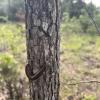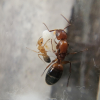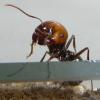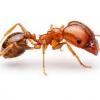Notes for a possible fiction story ...
Traditional ant names are based on one ant virtue as the first name and one ant “intimidating quality” as the last name.
For example:
- Temperance the Absconder
- Proportionally the Relentless
- Synchronicity the Amputator
- Alacrity the Calculating
- Efficiency the Eternal Witness
-----
Snapshot, The Subway:
The ants piled in to the subway car. Each had a newspaper. (by looking carefully at the header you could tell which colony they were from) Committed to business-like conduct & social order each ant had her paper folded into a strip, so she could read one column at a time without getting the paper in the faces of other passengers. Holding a sturdy leather strap with one tarsal claw, the paper with another & checking her pocket watch with a third, ants were the picture of urban sophistication.
I did feel a little out of place on the train full of ants. Their antennae neatly folded like the colony newspapers, they made excellent use of the space. No jostling, no arguments. Just a silence filled with pheromone conversations that I could not hear. A tall and elegant bull ant worker with bright dark eyes offered me her seat... as if being a human were a kind of infirmity. I took up her offer. I really needed to sit down.
---
Character idea:
A scholar who is a book louse larvae— he is deeply torn between completing his research by reading the books and eating them so that he can pupate (and maybe then, at last have the nerve to ask out the moth on whom he has a terrible unrequited, totally secret crush) Sometimes he eats books he finds poorly written out of spite.
“I had to miss a week of work sick in bed after eating Art of the Deal, but it seemed like a matter of personal duty to munch up that one. Worse I don’t think it helped my silk glands develop at all! Really I felt worse after the ordeal—had to nibble on a 1st edition of Nother’s tables just to get my bearings— and now all of the logarithms between 0.5 and 0.7 are missing.” He said with a little sob. “Whatever am I to do? I simply love my books far too much!”  Timothy! No! That's a first edition! And where are your spectacles! What has gotten in to you?
Timothy! No! That's a first edition! And where are your spectacles! What has gotten in to you?
-----
Character idea:
The provost is a very capable administrator but sometimes— well sometimes she has been known to sting people.
That morning I found an unwelcome guest in my office. The university provost, a lean an elegant bull ant with angry dark eyes. Her natural expression was so menacing it was hard to tell if she was ever pleased. Judging by her twice folded front legs and twitching right antennae —a good mood seemed even less likely.
“We need to talk about the new head librarian.” she said with formic acidity underlining each word.
“What? Timothy? but he’s so knowledgeable. He knows exactly where everything is in our collection!”
“Not hard when half of it ends up in your belly.” said the provost massaging her antennae ridges as if she were developing a headache.
“You must admit, large collections can benefit from culling— we can’t just stockpile every single useless book and paper.” I said hoping that Timothy had not eaten something too valuable this time.  ---
---
Character idea: Maculinea arion, a lovely blue butterfly and her murderous roommate the jewel wasp.
Timothy, book louse, is desperately in love with her, but little does he know that his love interest has a treacherous past, she grew up eating baby ants! She lives with her roommate, a femme fatal jewel wasp who is connected to the disappearance of several gentleman roaches. Only because the ants fail to take crime against roaches seriously has the jewel wasp not been caught.
When Timothy discovers what the woman he loves has done he is torn about exposing her. When Timothy starts looking in to her and her roommate-- he suddenly disappears! Our human exchange professor (and narrator) goes searching for Timothy fearing he has become a victim of the jewel wasp, a beautiful but horrible serial killer who paralyzes her victims then buries them alive as food for her young.

When she is finally captured the jewel wasp laughs at the police with contempt:
"You can't call me a murderer! None of my victims are even dead yet! And you'll never find them anyway. You should focus on that wicked blue butterfly, not me, I rid the world of PESTS!"
---
Snapshot: The Provost's Secretary
When I arrived at the provost's office I didn't know what manner of criticism I was to receive. Even in my nervous state I couldn't help but notice a peculiar rustling commotion under the long dress of her secretary, a near-sighted gray wolf spider who seemed just as flustered as I was. I craned for a better look, and saw a little spiderling peek from the ample hems of her skirts. This, it seemed, was too much for the secretary. She gave up all pretense of checking me in.
"Please oh please don't tell the provost I brought my children here!" begged the secretary. Of course I assured her I wouldn't say a word. But, after my meeting I did something that may have betrayed the confidence of the nervous mother. The provost followed me from her office, still giving instructions and criticisms of my work, and this was when I spotted a spiderling snuggled on the provost's gaster! Something in my demeanor betrayed my mirth at the situation.
The provost whirled around fixing her large and perpetually angry black eyes on her own bottom. Seeing the spiderling there she flew into a rage. Mandibles waggling at her secretary! She backed the poor spider into a corner. Then shouted
"If you bring them again you might as well look for another job!" and slammed her office door. I felt horrible. This was all my fault. I would be responsible for a mother of... um... a mother of many being out of work with no way to support her young.
So, of course I offered to babysit. To my surprise the spider was happy to trust me with such an important task and this is how she came to arrive at my apartment to drop the little ones off. She had packed them all into a large basket.
"They should stay in the basket. You don't need to do anything. Just don't leave them alone." Confident that I was helping I sat down at my desk to work on my research. After some time I felt something small and fuzzy nestling in to my leg.
It was one of the spiderlings of course. The basket simply didn't provide the comfort of mother. I attempted to move the little one back, but when I got close to the basket several more made their way on to my arms and chest. They looked up at me, each with 8 little black eyes. "mum?" they asked. Who was I to denny them?
Soon I was covered head to toe ... and though I tried to resume my paperwork, it could not be done. I stood in the middle of the room covered in spiders. I don't know how much time passed or how I didn't become over whelmed, but suddenly after a time they all poured off my body rushing to the door.
Thankfully it was their mother, and it was clear I was just a substitute since they made their way back to her rump with all haste. I had a few unsettling dreams, but I also resolved to talk to the provost about her intolerant attitude to children. I suppose ants can just leave their little ones at home, they have sisters who are nurse maids!
---
About The Biology:
The insects of the plant are people-sized, highly intelligent, with a diverse urban culture that brings many species of ant, and inquiline together. Our narrator is a human exchange professor at one of the finest ant universities in the biggest city on the planet. Of course, insects on earth have rarely grown to be such sizes. From what I understand there are two main constraints:
1. Exoskeletons present difficulties at larger scales.
2. Insects do not generally have active lungs, so getting O2 to all parts of the body presents problems as surface area decreases relative to mass in larger bodies.
The ants on the planet of the ants are very similar to earth ants, but this is convergent evolution at an extreme-- distant paths to a similar pattern rather than a familial relation. The exoskeletons of the ants are simply much stronger than the chitin of earth insects, due to a mutation that unleashed huge insects on their planet long ago-- and resulting in a very different evolutionary history. I would love to have some sources or speculation about just how the chemistry and structure of chitin might be altered to make this possible-- Also, these insects have something like lungs. Are there other biological considerations for huge insects? Could there be constraints on vertebrates on this planet that don't exist on earth? (A reason why all of the animals with backbones are tiny... maybe there's no calcium except deep in the ocean?
I really need to learn more about how mineral composition interacts with biology.) I've considered a lower gravity... but, don't like this much as it over-complicates human visitors. Their planet is like ours but on their planet the insects came out on top.
According to the ants, every planet they have visited has contained some life that is similar to ants: because ants are perfect. This isn't true for humans, many planets don't have anything like vertebrates at all. The ants suppose that being ant-like is a pre-requisite to having space travel and advanced civilization. But, a discovery in their desert on their home planet could throw all of this into question!
---
More Notes on Ant Culture:
Until recently male ants had no role in society, but recent medical treatments have extended their once feeble life-spans allowing them to take on more responsibility in ant cultures and societies. Worker ants are generally uninterested in lives of reproductives, though there is a certain romance attached to old tales of young queens and drones, naive and winge'd looking for a place in the world. Such imagery is important in ant artwork. "The winged couple seeking a new home"
There was a bit of a problem with homeless drones wandering around cities, but ants have low tolerance for social disorder or needless suffering and they established a system of dormitories. In the following photo some girls are dragging their little brothers out of the nest for nuptial flight day. But, this is very primitive, and "flying days" are now just general holidays: it's considered barbaric to force young queens and drones to all go fly at once. The modern way in the civilized Ant Planet is to give them time to grow up and find their own way.
On the Planet of the Ants, army ants are seen as primitive and taboo-- in particular their practice of making bivouacs has been outlawed-- it's complex, since raiding is objectively violent and not really compatible with a modern technological civilization-- but, only extremist traditionalist army ants still want to have raids-- (and their disgust with the factory aphid farms has a point) Arguably, simply choosing to form a bivouac ought to be legal and it's unfair that it is criminalized.
The university where our human narrator is an exchange professor from earth suddenly goes into lock down when a column of army ants advance. Everyone is terrified and our narrator gets caught up in the fear-- only to discover that these ants have been coming to a particular great tree to form a bivouac for centuries -- and they don't "kill and eat everyone they meet" -- having been on the bad side of ant-centric thinking our narrator starts to question what is being taught about the army ants.
She is even invited to enter their bivouac, a living building where the ants who form the walls and floors gently move you through the rooms and passageways. It is an experience that fills our narrator with awe!
She also learns from the army ants about the vast factory farms that feed the great cities-- and thinking on the food production on earth wonders if she's in a position to really judge-- though she accepts that it's probably wise to be unsettled by such things as some of the army ants she meets suggest.
Edited by futurebird, May 29 2023 - 5:52 AM.




















